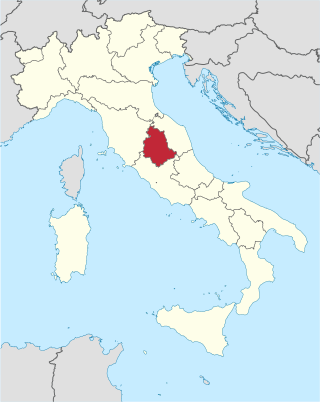
Umbria is a region of central Italy. It includes Lake Trasimeno and Marmore Falls, and is crossed by the Tiber. It is the only landlocked region on the Apennine Peninsula. The regional capital is Perugia.

Terni is a city in the southern portion of the region of Umbria, in Central Italy. It is near the border with Lazio. The city is the capital of the province of Terni, located in the plain of the River Nera. It is 104 kilometres northeast of Rome and 81 km south of the regional capital, Perugia.

Spoleto is an ancient city in the Italian province of Perugia in east-central Umbria on a foothill of the Apennines. It is 20 km (12 mi) south of Trevi, 29 km (18 mi) north of Terni, 63 km (39 mi) southeast of Perugia; 212 km (132 mi) southeast of Florence; and 126 km (78 mi) north of Rome.
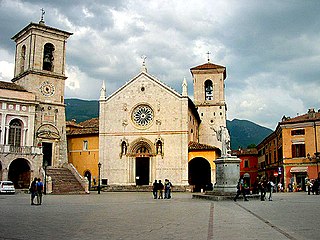
Norcia, traditionally known in English by its Latin name of Nursia, is a town and comune in the province of Perugia (Italy) in southeastern Umbria. Unlike many ancient towns, it is located in a wide plain abutting the Monti Sibillini, a subrange of the Apennines with some of its highest peaks, near the Sordo River, a small stream that eventually flows into the Nera. The town is popularly associated with the Valnerina. It is a member of I Borghi più belli d'Italia.

The province of Terni is the smaller of the two provinces in the Umbria region of Italy, comprising one-third of both the area and population of the region. Its capital is the city of Terni. The province came into being in 1927, when it was carved out of the original unitary province of Umbria.
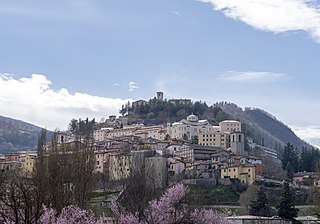
Cascia is a town and comune (municipality) of the Italian province of Perugia in a rather remote area of the mountainous southeastern corner of Umbria. It is about 21 km from Norcia on the road to Rieti in the Lazio (63 km). It is also very close to Terni.

Trasimène was a department of the First French Empire from 1809 to 1814 in present-day Italy. It was named after Lake Trasimeno. It was formed on 15 July 1809, when the Papal States were annexed by France. Its capital was Spoleto.

The province of Rieti is a province in the Lazio region of Italy. Its capital is the city of Rieti. Established in 1927, it has an area of 2,750.52 square kilometres (1,061.98 sq mi) with a total population of 157,887 people as of 2017. There are 73 comuni in the province.
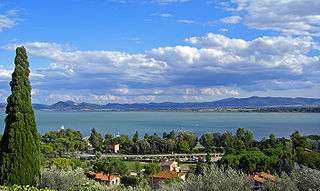
Lake Trasimeno, also referred to as Trasimene or Thrasimene in English, is a lake in the province of Perugia, in the Umbria region of Italy on the border with Tuscany. The lake has a surface area of 128 km2 (49.4 sq mi), making it the fourth largest in Italy, slightly smaller than Lake Como. Only two minor streams flow directly into the Lake and none flows out. The water level of the lake fluctuates significantly according to rainfall levels and the seasonal demands from the towns, villages and farms near the shore.

Monteleone di Spoleto, is a town and comune of Italy, in the province of Perugia in southeast Umbria at 978 meters (3,209 ft) above sea-level overhanging the upper valley of the Corno River. It is one of the more remote towns in Umbria, on a mountain road from Norcia and Cascia to Leonessa and Rieti in the Lazio. It is one of I Borghi più belli d'Italia.

Bettona is an ancient town and comune of Italy, in the province of Perugia in central Umbria at the northern edge of the Colli Martani range. It is 5 km (3 mi) E of Torgiano and 12 km (7 mi) SW of Assisi. It is one of I Borghi più belli d'Italia. Passaggio, Colle and Cerreto are frazioni of the comune.
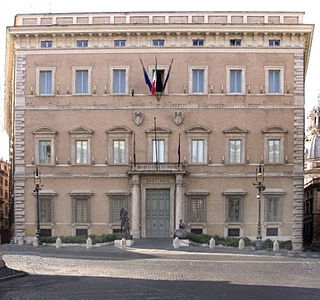
The province of Rome was one of the five provinces that formed part of the Lazio region of Italy. It was established in 1870 and disestablished in 2014. It was essentially coterminous with the Rome metropolitan area. The city of Rome was the provincial capital. During the 1920s, the boundary of the province shrank as land was ceded to establish new provinces. The province of Rome was the most populous province in Italy. On 1 January 2015, it was superseded by a new local government body—the Metropolitan City of Rome Capital.
Maggiore means "major" or "large" in Italian. It can refer to:
There are 70 community bands, 110 community choirs, and about 20 secondary music schools. The region is famous for its music festivals, including the Festival dei Due Mondi in Spoleto and the Umbria Jazz Festival.

Sant'Anatolia di Narco is a comune (municipality) in the Province of Perugia in the Italian region Umbria, located about 60 km southeast of Perugia, in the middle Valnerina valley. It is a medieval town commanded by a 12th-century castle, with a 14th-century line of walls.

Stroncone is a comune (municipality) in the Province of Terni in the Italian region Umbria, located about 70 km southeast of Perugia and about 8 km south of Terni. It is one of I Borghi più belli d'Italia.

Poggio Mirteto is a comune (municipality) is situated in the Tiber Valley Central Italian region of Latium. Administratively Poggio Mirteto is in the province of Rieti and geographically this municipality is about 45 kilometres (28 mi) northeast of Rome and about 20 kilometres (12 mi) southwest of Rieti.
Andrea Vici (1743–1817) was an Italian architect and engineer, active in a Neoclassical style. He was a pupil of Luigi Vanvitelli, and active in the Papal States comprising parts of Lazio, Umbria, and Marche.






















